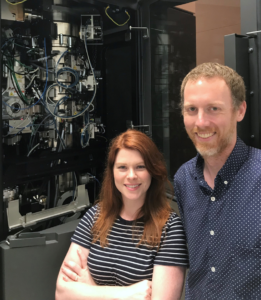Facility Spotlight: Cryo-EM Facility

The CSB Cryo-Electron Microscopy Facility houses three Thermo Scientific cryo transmission electron microscopes for high resolution data collection of biological specimens by tomography and single-particle analysis. The goal of the facility is to make TEM accessible to all interested researchers at Vanderbilt.
The staff provides extensive training to new users in the facility. They also provide advice and support in specimen preparation, data collection and image processing, computational image analysis, and structure determination. Visit the CSB Cryo-EM website to schedule training or for more information.
Who are the facility staff? Scott Collier & Melissa Chambers, Facility Directors, and Mariam Haider, Research Associate
What instrumentation and services are currently provided at this facility? We have 4 transmission electron microscopes (TEMs) ranging from a 100kV screening TEM to the 300kV Titan Krios G4 and instrumentation to prepare both negatively-stained and vitrified grids. We offer training in grid preparation, microscope operation, and imaging strategies. We train users to operate all equipment on their own, except for the Titan Krios which is run by staff. Staff can take on a limited number of projects when time is available.
What are the kinds of scientific challenges which can be addressed using the instrumentation at this facility? EM and cryo-EM are used for structure determination of molecular assemblies without the need for crystallization and often in near-native conditions. The complexes can range in size from several megadaltons down to (very challenging) 20kDa and resolutions can be as high as 1.7 angstroms. While homogeneity is a strength for obtaining high-resolution data, EM can evaluate flexible complexes and conformational changes and can yield data at lower resolution that also informs scientific questions.
What are some of the most interesting/challenging projects you’ve worked on here? We see a variety of projects in the facility from SARS-CoV-2 antibodies, large molecular motors, small GPCRs, and subtle conformation changes of a complex due to drug binding. The facility is also imaging more of these complexes in cells, which is an exciting area, merging cell and structural biology. It is great to be present when a user visualizes a complex that, until then, they had only seen as bands on a gel or peaks on a plot.
What was your path to becoming a facility director, and your favorite part of this job? (Melissa) I started in the cryo-EM field as lab manager in Melanie Ohi’s lab here at VU in 2007. I was new to the EM world and learned everything with on-the-job training. I was fortunate to be present when 2 of the TEMs were being installed and learned so much from watching and listening to the engineers during the process. The field of cryo-EM began to dramatically expand around 2014 while I was working with the instruments at Harvard Medical School. There I was able to help establish two core facilities and then moved back to Vanderbilt in 2019. I’ve always enjoyed helping others understand challenging topics and master these difficult skills.
(Scott) My path to being a cryo-EM facility director started with an undergraduate summer program where I was placed in a crystallography lab at the University of Kentucky. There I learned about protein purification and fell in love with structural biology when I saw a 3D model of a protein. From Kentucky, I attended graduate school at Vanderbilt where I focused my attention on learning more about structural biology. After rotating in several CSB associated labs, naively I only wanted to learn more about crystallography and had little to no interest in learning more about NMR or cryo-EM. I soon realized this rigid approach was not very scientific and adapted to use NMR for my primary graduate school publication and focused on learning cryo-EM through several collaborations. Once I graduated from Vanderbilt, the cryoEM facility director positioned opened up and it felt like a natural transition. One of my favorite parts of the job is helping users see their sample for the first time. There are so many hurdles in the cryoEM workflow that it is such a relief to get the first cryoEM images.
What do you think is the key to running a successful facility? The key to running a successful facility is thinking of the users as customers of your weird, small business. What do they need to be successful and how can you make it easier/simplified/approachable for them? Work to meet those criteria while considering your staff, instrumentation, and financial support.
Leave a Response
You must be logged in to post a comment